331 results
Higher education chemistry independent work packets
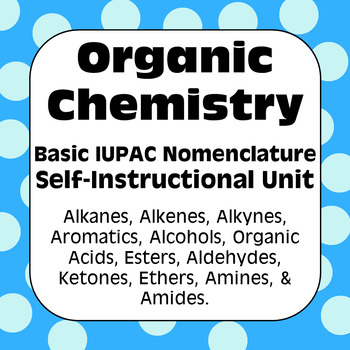
Chemical Nomenclature: Self-guided Unit for High School Organic Chemistry
Updated with current IUPAC nomenclature. This self-instructional unit with step-by-step instructions, examples, problems and room for student answers, is an effective introduction to organic chemistry nomenclature especially for senior/AP biology, biochemistry, and chemistry students. Use it prior to your unit on biochemistry/functional groups. This package covers the following compounds: alkanes, alkenes, alkynes, aromatics, alcohols, organic acids, esters, aldehydes, ketones, ethers, amines
Subjects:
Grades:
11th - 12th, Higher Education, Adult Education
CCSS:
NGSS:
HS-PS1-1
, HS-PS1-2
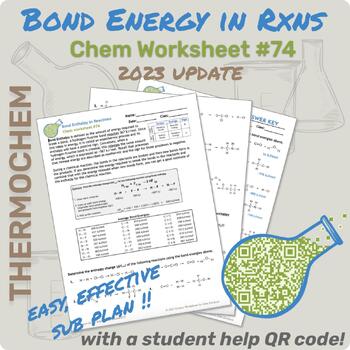
74-Bond Enthalpy in Reactions Worksheet
Concepts:Students will calculate the enthalpy change (∆H) in kilojoules per mole for chemical reactions using bond energies. The Lewis structures for various compounds are drawn and students look up the bond energy for each in the table provided on the worksheet. At the end of this assignment students draw their own Lewis structures and then find the enthalpy change using bond energies.How I Use This:I give this assignment after I teach students about determining the number of valence electrons
Subjects:
Grades:
8th - 12th, Higher Education
Also included in: Complete Set of Chem Worksheets
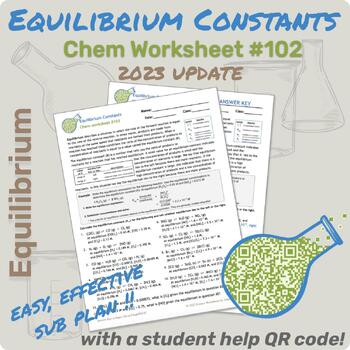
102-Equilibrium Constants Worksheet
Concepts:This assignment gives students practice setting up equilibrium expressions and using those to calculate an equilibrium constant (Keq). Students are given a balanced equation and equilibrium concentrations and from these they find K. They will learn that the constant (K) is a ratio of [products] / [reactants], so a large K indicates large concentration of products at equilibrium, while a small K means a large concentration of reactants at equilibrium. Based on the value of K, they can pr
Subjects:
Grades:
10th - 12th, Higher Education
Also included in: Complete Set of Chem Worksheets
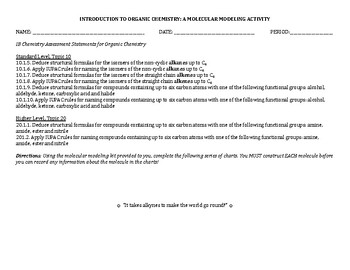
Molecular Modeling In Organic Chemistry: Functional Groups - Structures & Naming
This packet was a labor of love. I could not find any resources for which I cared that tackled the challenge of organic chemistry functional group structures and nomenclature, so I made my own. The first trial run had my students (International Baccalaureate Chemistry) working for almost two weeks to complete it while painstakingly building each organic molecule and completing the packet. I completed the packet right along with them in class, moving from small group to small group and asking tar
Subjects:
Grades:
11th - 12th, Higher Education

Density Unit (includes easy prep labs)
Density unit includes: bell ringer writing promptsshort engaging video clipsstudent interactive notebook pagesGoogle slides deck that walks your students through all of the activities easy prep density labsnotes and activities to address underpinning learning targets like mass vs weight, how to calculate volume etc)class discussion promptsdensity word problems practicebuilt in timers
Subjects:
Grades:
6th - 12th, Higher Education, Adult Education
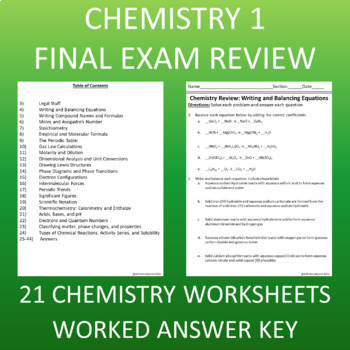
Chemistry 1 Final Exam Review: 21 Single Page Worksheets on Chemistry Topics
Do you need a review for your Chemistry students to help them get ready for the final exam? This product might help. It covers topics usually covered in a Chemistry 1 course in a high school or college setting. I'm calling this product a modular review. That means that each page is self-contained. You can use the pages you want and leave out the pages you don't. If you didn't cover a topic, no problem, just don't give that page to the students. It could even help you prepare for the Chemistry pr
Subjects:
Grades:
9th - 12th, Higher Education
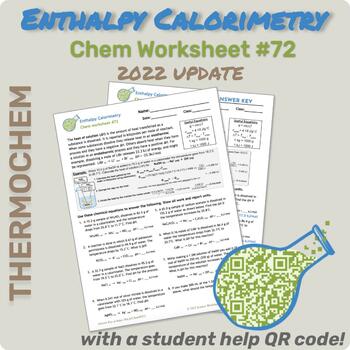
72-Enthalpy Calorimetry Worksheet
Concepts:This worksheet teaches students to perform enthalpy calorimetry calculations. This uses the heat equation: Q = mc∆T and requires conversion of gram to moles and joules to kilojoules. Students calculate the molar heat of solution (∆H) for a variety of solutes. This worksheet includes a couple of higher level thinking problems at the end. All required formulas are on the worksheet, but a periodic table is recommended.How I use this:I assign this after students have learned to use the spec
Subjects:
Grades:
10th - 12th, Higher Education
Also included in: Complete Set of Chem Worksheets
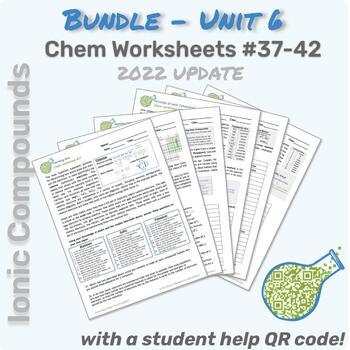
UNIT 6 - IONIC COMPOUNDS WORKSHEETS BUNDLE (#37-42)
This is a bundle of six printable worksheets that teach students about ionic compounds and how they form. These worksheets follow a natural progression, first teaching students how ions form from atoms, and why the common ions have the charges they do. This worksheet introduces the octet rule as a basis for ion formation. The pattern of common ions charges is illustrated using the element's position on the periodic table. The next worksheet explains why magnesium would combine with two chloride
Subjects:
Grades:
8th - 12th, Higher Education

HOW TO GROW PLANTS In My Biology Classroom STEM PREMIUM PROJECT 2-6 WEEKS
*****STAR SALE $19.99 PREMIUM STEM BIOLOGY PROJECT HOW TO GROW PLANTS—WHAT PLANTS NEED TO GROW IN-CLASS LAB AND PROJECT 2-6 WEEKS FUN! FUN! FUN! OBJECTIVE: List three nutrients plants get from soil. List two ways you can add nutrients to soil. Describe three factors to consider when growing plants. 3 = ACTIVITIES Use a map of plant hardiness zones to identify the zone where you live. List two ways to grow a new plant. *****STAR SALE $19.99 PREMIUM STEM BIOLOGY PROJECT
Subjects:
Grades:
7th - 12th, Higher Education, Adult Education
NGSS:
MS-LS1-5
, HS-LS1-5
, MS-LS1-2
, HS-LS1-7
, MS-LS1-3
...
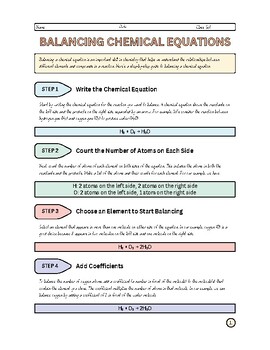
Balancing Chemical Equations Packet
A comprehensive 21 page packet that not only explains how to balance chemical equations, but give students ample opportunities to practice what they have learned! *Complete with answer keys to some of the pages*
Subjects:
Grades:
Higher Education
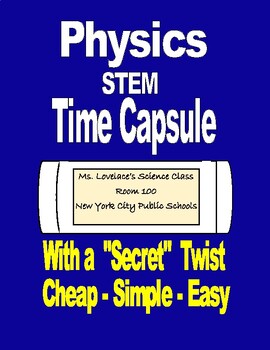
PHYSICS TIME CAPSULE With A SECRET $$$ Saving TWIST 3-DAY ACTIVITY 18-PAGES
*****STAR SALE $19.99 PHYSICS TIME CAPSULE APREMIUM PHYSICS IN-CLASS ACTIVITY 3-DAYS 18-PAGES OBJECTIVE: The Student Will: DEMONSTRATE an understanding that in science, a time capsule is a historic cache of goods or information, usually intended as a deliberate method of communication with future people, and to help future archaeologists, physics students, anthropologists, or historians . . . BY . . . CONSTRUCTING a time capsule that will hold the materials placed in it, for an indefinite period
Subjects:
Grades:
7th - 12th, Higher Education, Adult Education
NGSS:
MS-ESS3-2
, MS-ESS3-1
, HS-ETS1-2
, HS-ESS3-3
, 5-ESS3-1
...
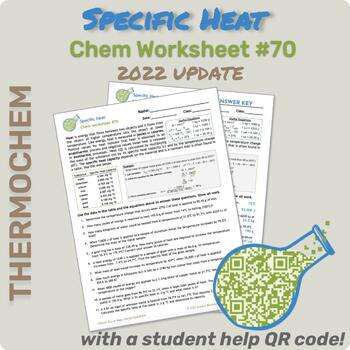
70-Specific Heat Worksheet
Concepts:Students will practice calculating heat (Q) using the equation Q = mc∆T. It introduces the concept of specific heat capacity, and includes several problems that require conversions. Students will solve for heat (joules), mass (g), temperature change (ºC) and specific heat capacity (J/g ºC). All the necessary formulas and conversion factors are on the worksheet.*Note - this worksheet is a good primer for 72-Enthalpy Calorimetry Worksheet.__________________________________________________
Subjects:
Grades:
8th - 12th, Higher Education
Also included in: Complete Set of Chem Worksheets
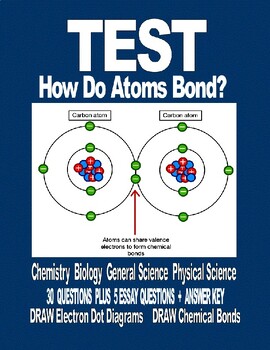
Chemistry Test - HOW DO ATOMS BOND? and ANSWER KEY 12-PAGES
*****STAR SALE $19.99 TEST How Do Atoms Bond? 30 Questions, 8 Drawings, 5 Essay Questions ANSWER KEY INCLUDED Atomic bonding is chemical bonding. Chemical bonding is the physical process that is responsible for the interactions between atoms and molecules. Bonds vary widely; there are covalent, ionic, hydrogen, and metallic, as well as many other types of bonds, and all have a working connection in all living things. This test covers the basic bonding of atoms; Electron-Dot Diagrams, and drawing
Subjects:
Grades:
7th - 12th, Higher Education, Adult Education
NGSS:
HS-PS1-6
, MS-PS1-4
, MS-PS1-2
, MS-PS1-3
, MS-ESS3-3
...
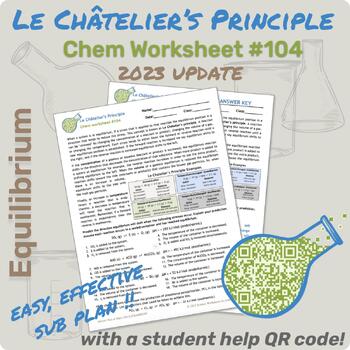
104-Le Chatelier's Principle Worksheet
Concepts:This assignment gives students practice in predicting how a 'stress' placed on a system at equilibrium shifts the reaction forward (right) or to the reverse (left). Stresses include increasing or decreasing the concentration of reactants and products, changing the temperature, and altering the pressure by changing the volume. Examples are given for both endothermic and exothermic reactions.How I Use This:First I make sure that students know what equilibrium means and how we can quantify
Subjects:
Grades:
9th - 12th, Higher Education
Also included in: Complete Set of Chem Worksheets
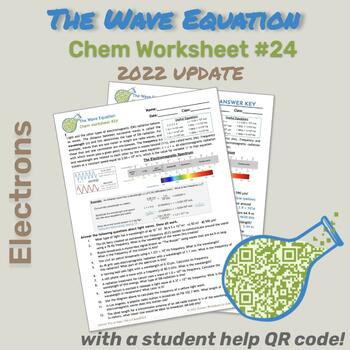
24-Wave Equation Worksheet
Concepts:This assignment is designed to teach students how to use the wave equation (c=λ×ν) to calculate the frequency and wavelength of various types of electromagnetic radiation. This provides a great opportunity for students to practice some simple algebraic calculations while applying them to light waves. It also includes practice reading data from diagrams since it includes an electromagnetic spectrum diagram. The problems on this assignment apply measurements to real-world uses of EM radia
Subjects:
Grades:
8th - 12th, Higher Education
Also included in: Complete Set of Chem Worksheets
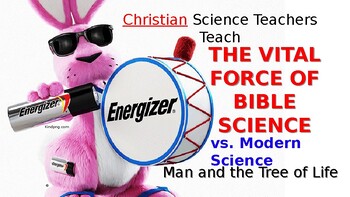
The VITAL FORCE of BIBLE SCIENCE for CHRISTIAN SCIENCE TEACHERS 53-PAGES
*****STAR SALE $19.99 THE VITAL FORCE OF BIBLE SCIENCE vs. MODERN SCIENCE 53-PAGES OBJECTIVE: The Student will work in groups of FOUR students to DEMONSTRATE an understanding that .There is a difference in the vital force, of the bible, then what modern science does/does not say about what makes something alive (characteristic of living things) . . . There is a difference between Special Creation (6,000 years) vs. Evolution (Millions of years) . . . And you cannot believe both because they confl
Subjects:
Grades:
7th - 12th, Higher Education, Adult Education
NGSS:
MS-LS4-3
, MS-LS4-1
, HS-LS4-2
, HS-LS4-1
, MS-ESS3-5
...
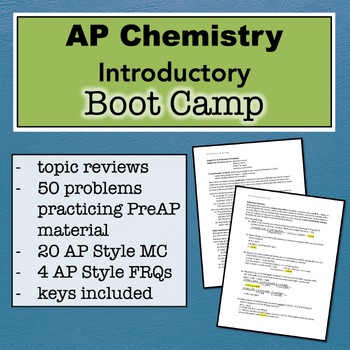
AP Chemistry Introductory Boot Camp
This boot camp is intended for use at the beginning of AP Chemistry for students to acclimate to the speed, style, and rigor of AP questions. This would make a good summer assignment, or review for a student who had a year off from chemistry prior to AP. Practice & review on the following:metric conversionspolyatomic ionsmolar mass/moles/stoich conversionsmolarity & density calculationsreactions - types & balancingempirical & molecular formulasThere are 50 skills questions broken
Subjects:
Grades:
11th - 12th, Higher Education
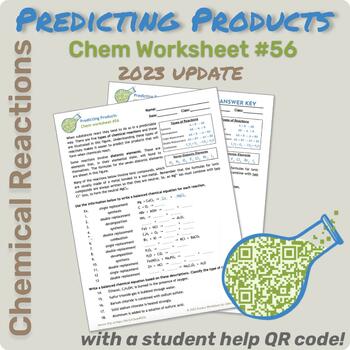
56-Predicting Products of Chemical Reactions Worksheets
Concepts:This worksheet teaches students to identify and write the five main types of chemical reactions: synthesis (direct combination), decomposition, single replacement, double replacement, and combustion. The first 13 reactions provide the reaction type and a partial equation (either reactants or products) for students to complete. The last five reactions harken back to the equation writing question that was common on the older AP chemistry test. Students are told the reactants (or the react
Subjects:
Grades:
8th - 12th, Higher Education
Also included in: Complete Set of Chem Worksheets
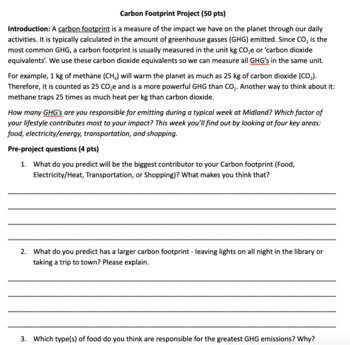
Carbon Footprint Project: High School Chemistry or Environmental Science!
This is the project packet for a comprehensive Carbon Footprint analysis for a student in high school or college! Fully editable for your context & place :)~~~~PART 4 OF LARGER CARBON FOOTPRINT BUNDLE (see description below)~~~~This project gives a template for students to calculate their Carbon footprints using skills that are important for Chemistry and/or Environmental Science (e.g. dimensional analysis, understanding the carbon cycle, understanding that different gases have different war
Subjects:
Grades:
8th - 12th, Higher Education
NGSS:
HS-ESS3-3
, HS-ESS3-2
, HS-ESS3-1
, HS-ESS3-5
, HS-ESS3-6
...
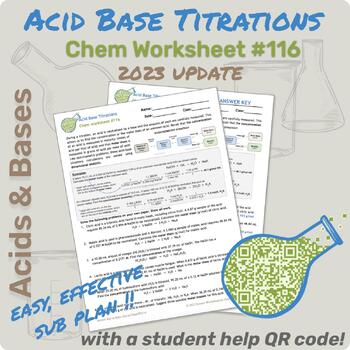
116-Acid Base Titrations Worksheet
Concepts:Students will perform more challenging stoichiometry calculations on this chemistry worksheet. They will calculate molar mass or molarity of an unknown substance using data from a titration experiment. This assignment teaches students to use dimensional analysis to calculate the molar mass or molarity using monoprotic, diprotic and triprotic acids. As with the other stoichiometry worksheets in this series (63-Stoichiometry, 93-Solution Stoichiometry, and (84-Gas Stoichiometry), there is
Subjects:
Grades:
10th - 12th, Higher Education
Also included in: Complete Set of Chem Worksheets
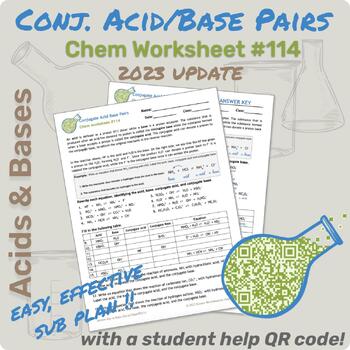
114-Conjugate Acid Base Pairs Worksheet
Concepts:On this chemistry worksheet, students practice identifying acids, bases, and their conjugate pairs. They recognize that an acid is the substance that donates a hydrogen ion, while a base receives it. They will write acid-base equations, identifying which substance is donating and which is accepting the proton based on the products formed in the reaction.How I Use This:After defining what an acid and a base is, we begin practicing writing equation for these. This is a great way to tell i
Subjects:
Grades:
10th - 12th, Higher Education
Also included in: Complete Set of Chem Worksheets

Advanced Chemistry Course Guided Practice Questions & Answer Key
This substantial bundle has all of the Guided Practice Questions that accompany the lecture notes/PowerPoints for a 15-unit advanced chemistry course. Each Guided Practice Questions document follows the instruction provided in the PowerPoints (and are often referenced within the PPT document) for each unit and includes the answer key. Teachers have often chosen to use these as either a tool to check for understanding or to verify that the students have been participating in class.
Subjects:
Grades:
9th - 12th, Higher Education
NGSS:
HS-PS1-8
, HS-PS1-1
, HS-PS3-2
, HS-PS1-4
, HS-PS1-6
...
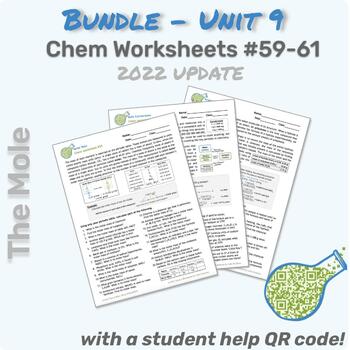
UNIT 9 - THE MOLE WORKSHEETS BUNDLE (#59-61)
This is a bundle of three printable worksheets that contain an introduction to the chemistry mole. They begin with instruction on how to calculate the molar mass for elements and compounds. Next, they introduce mole conversions using this diagram as a road map for conversions. Finally, they contain some simple calculations to determine the formulas for hydrates which make use of mass to moles conversions and the use of ratios.Each worksheet in this packet contains instruction, explanations, and
Subjects:
Grades:
9th - 12th, Higher Education

UNIT 4 - ELECTRONS WORKSHEETS BUNDLE (#24-29)
This is a bundle of six printable worksheets that teach students all about the electrons in an atom. They begin with instruction on how wavelength and frequency are related, teaching students to use the wave calculation and to practice scientific notation. This is followed by an introduction to Planck's equation which allows students to determine the energy of a photon from its frequency. Then students will combine this knowledge and apply it to the hydrogen atom, performing some simple calculat
Subjects:
Grades:
9th - 12th, Higher Education
Showing 1-24 of 331 results





